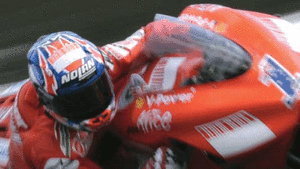People said he'd never make it. Some of his doubters said he'd chosen the wrong teams, others said he had passed his "used by date" and would never win a Grand Prix. However, none of the criticisms deterred Australia's own Formula 1 hopeful Mark Webber from claiming his first Grand Prix victory, as well as the pole position, in Germany in July 2009.
Webber's road to success, competing at the highest level of motor sport for eight years, has had more twists and turns than some of the tracks he's raced on. Since his teenage years, the "kid from Queanbeyan" (near Canberra) had wanted to be a F1 driver, but his rise to fame and fortune has been fraught with difficulties and ill-fortune. Most would have abandoned all hopes of achieving such a dream early on, but not Webber.
What kept him going was determination and hard work, courage, perseverance and faith in his own ability coupled with help, encouragement and support from family and friends.
early scare
Webber began his career racing karts, winning various titles in the early nineties before climbing the steps to Formula Ford in Australia and then Great Britain. He accumulated more trophies, including the 1997 Rookie of the Year award, in the British Formula Three Championship.
The talented young Aussie attracted the attention of Mercedes Benz, who hired Webber as a factory driver in the GT Sportscar Championship, where he earned a creditable second in 1998.
Then, while preparing for the 1999 prestigious Le Mans 24-Hour classic, he experienced the most terrifying moment of his career. "At a speed nudging 330 kph, the car began to get airborne, soaring over tree-tops and reaching a height of three to four storeys before doing a few flips. It then plummeted back to earth, disintegrating on impact," explains Webber.
Miraculously, he crawled from the wreckage shaken, but unhurt. However, when he drove the spare car the next day, the horrific experience was repeated, albeit a little slower at 310 kph. As the car was lifting off, he recalled thinking, "Well I got out of the last one. I should be OK."
Webber may have been physically unhurt, but his skills (or lack therof ) were blamed for both incidents, tarnishing his reputation. It was only when his teammate suffered a similar experience that it was proved that the fault lay with the car's aerodynamics and design, and not the driver. Mercedes- Benz withdrew from the competition and never raced the cars again but Webber's career was left in near tatters.
reviving the dream
"I felt a million miles from Formula 1," said the then 22-year-old of his childhood dream. "I was very concerned about my future. It wasn't looking too sparky."
Miraculously, an Australian came to the rescue. Airline owner, businessman and motorsport enthusiast Paul Stoddart arranged a Formula 3000 drive for Webber with Arrows. After yet another Rookie of the Year award, the rising young star was revitalised and one step closer to achieving his F1 ambition.
Then came a test-drive with respected Benetton F1 team in 2001, with Stoddart again stepping into the picture, offering him a drive in his team for 2002. The team wasn't exactly the front of the pack, but it was at least an F1 seat, and this promising young talent had finally reached the elite category.
Webber's debut at Melbourne's Australian Grand Prix (AGP), with his famous but completely unexpected fifth place, remains part of history.
Being "addicted to success," Webber wasn't prepared to sit back, so the following year he switched to Jaguar (with Stoddart's blessing). After two, nonproductive years with the struggling mid-field Jaguar team, Webber accepted a seat at Williams-BMW, a oncedominant force.
"I'm very privileged to drive for Williams, it's a great team. I want to be world champion next year, but the reality of doing that will be incredibly tough," admitted Webber then.
Team owner Sir Frank Williams chose him because of his strong mental approach and character. "He always drives to the end of the car's capabilities. He takes his job very professionally and is certainly inspirational."
Away from the fanfare of F1, life isn't all glamour and high living. It's based around dedication, hard work, determination and self-belief.
Webber lives in rural Buckinghamshire, England with his manager and partner Ann, his two dogs and two donkeys, Ned and Oliver.
Although Webber accepted the path to victory would be rough and winding, he always expected to stand on top of the pyramid one day.
away from the tracks
Webber is as committed to helping those in need as he is to becoming world champion. As a Qantas ambassador, this proud Australian also helped disadvantaged young people from Mission Australia and Starlight Foundation enjoy a day out at Melbourne's AGP.
"I have a basic life, and I enjoy giving back to people who may not have been as lucky," explains Webber.
Inspired by his love of the outdoors, Webber also started a 10-day, 1000 km adventure triathlon in Tasmania in 2003, raising money for children with cancer. Such was its success that The Mark Webber Pure Tasmania Challenge has become a much-anticipated, annual event, raising in excess of $1 million for several Australian charities.
In 2008, Webber's career nearly ended while on his annual Pure Tasmania Challenge. During the mountain bike leg of the challenge, he was hit head-on by a 4WD vehicle, badly breaking his right leg.
It was feared that he couldn't recover in time to test and race his race car at Melbourne's opening F1 round. But Webber had other ideas. The 32-yearold pushed through the pain barrier, punishing his body with a rigorous rehabilitation routine in a bid to regain his peak level of fitness. Along with intense gym sessions and swimming, he also subjected his body to a Cryogenic Chamber with freezing temperatures in an attempt to speed up his recovery.
More focused and determined than ever to succeed, and ignoring the lingering pain, he took his place on the starting grid for the 2009 Australian Grand Prix. But all his efforts were in vain. He got caught up in some firstcorner carnage and his car emerged badly damaged.
"It's one of the most frustrating and disappointing things that's happened to me," he admitted.
champion, finally
Then came an overdue change of fortune with some encouraging podium places and points haul for the Red Bull team. At long last, after 130 attempts, he secured his prized pole position and breakthrough triumph at the demanding N




